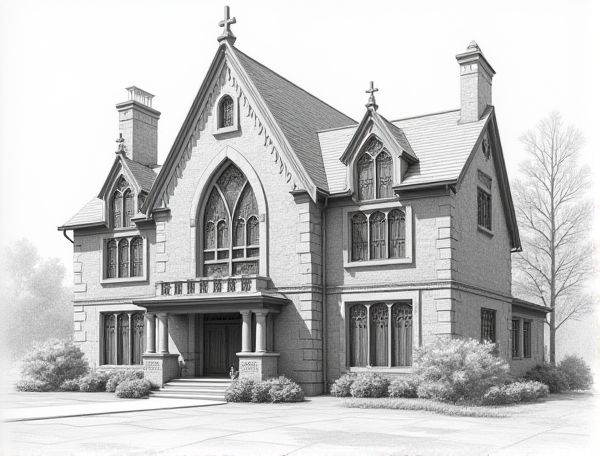
Photo illustration: Gothic Revival home design with trefoil stained glass
Gothic Revival home design incorporates intricate architectural details, pointed arches, and trefoil stained glass windows that add a timeless, elegant charm to your living space. Explore how these historic elements can transform your home by reading more in the article.
Introduction to Gothic Revival Home Design
Gothic Revival home design highlights pointed arches, intricate tracery, and steeply pitched roofs that create a dramatic medieval aesthetic. This architectural style often incorporates ornate woodwork, lancet windows, and decorative finials, providing a timeless sense of elegance and grandeur. Your home can capture the historic charm and romanticism of Gothic Revival by integrating these distinctive elements into its overall design.
Historical Roots of Gothic Revival Architecture
Gothic Revival architecture, emerging in the late 18th century, draws inspiration from medieval Gothic design elements like pointed arches, ribbed vaults, and flying buttresses, reflecting a romanticized appreciation for the Middle Ages. Your home design can incorporate these historically rich features to evoke timeless elegance and intricate craftsmanship indicative of the Gothic Revival movement.
Key Features of Gothic Revival Homes
Gothic Revival homes showcase key features such as pointed arches, steeply pitched roofs, and intricate wooden trim known as vergeboards, creating a dramatic, historic aesthetic. Your design can also incorporate tall, narrow windows with stained glass and decorative finials to enhance the medieval-inspired charm.
The Symbolism of Trefoil in Gothic Design
The trefoil, a prominent motif in Gothic design, symbolizes the Holy Trinity, reflecting the period's deep religious significance and architectural devotion. Its three-lobed shape often appears in windows, arches, and tracery, enhancing both aesthetic beauty and spiritual meaning in home designs. Incorporating trefoil elements into modern interiors evokes timeless elegance and connects contemporary spaces to historic Gothic artistry.
Stained Glass in Gothic Interiors
Stained glass in Gothic interiors transforms your home with vibrant colors and intricate patterns that embody medieval artistry and spiritual symbolism. The interplay of natural light through richly colored glass panels enhances the dramatic arches and ribbed vaults typical of Gothic architecture. Incorporating stained glass into your design not only elevates visual appeal but also infuses a sense of history and craftsmanship into your living space.
Incorporating Trefoil Stained Glass Windows
Incorporating Trefoil stained glass windows enhances your home's aesthetic with intricate, three-lobed designs that infuse spaces with vibrant colors and historical charm. These windows optimize natural light diffusion while serving as unique focal points that elevate both traditional and modern interior styles.
Color Palettes for Gothic Revival Interiors
Deep, rich color palettes featuring jewel tones like emerald green, ruby red, and sapphire blue create the perfect ambiance for Gothic Revival interiors, enhancing their dramatic and historic appeal. Incorporating dark wood finishes and metallic accents with muted gold or bronze further elevates Your space, evoking authentic medieval elegance.
Furniture Choices for a Gothic Revival Home
In a Gothic Revival home, your furniture choices should emphasize dark wood pieces with intricate carvings, pointed arches, and ornate details that reflect medieval craftsmanship. Incorporate heavy, upholstered chairs and rich fabrics like velvet or brocade to enhance the dramatic, historic ambiance.
Blending Modern Elements with Gothic Revival Style
Blending modern elements with Gothic Revival style creates a unique home design that highlights intricate arches, pointed windows, and ornate detailing alongside sleek lines and contemporary materials. Using glass, steel, and minimalistic furniture juxtaposed with dark wood, stained glass, and wrought iron accents enhances the dramatic aesthetic while maintaining functionality. Incorporating ambient lighting and open floor plans further balances the historic grandeur with modern comfort and practicality.
Tips for Restoring or Maintaining Trefoil Stained Glass
Use a soft, lint-free cloth and a mild, non-ammonia cleaner to gently wipe trefoil stained glass, avoiding harsh chemicals that can damage the lead came and glass surface. Inspect the solder joints annually for any signs of cracking or corrosion, and consult a professional restorer to re-secure loose sections and apply protective wax to extend the glass's longevity.
 homedesy.com
homedesy.com